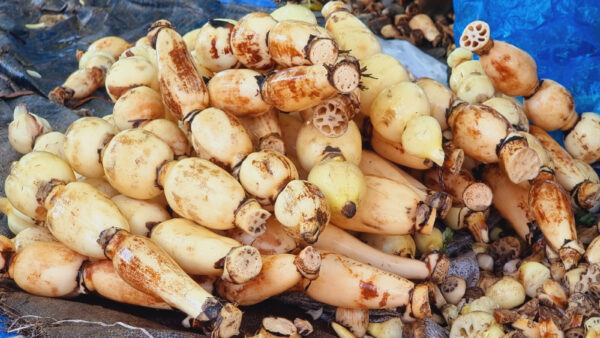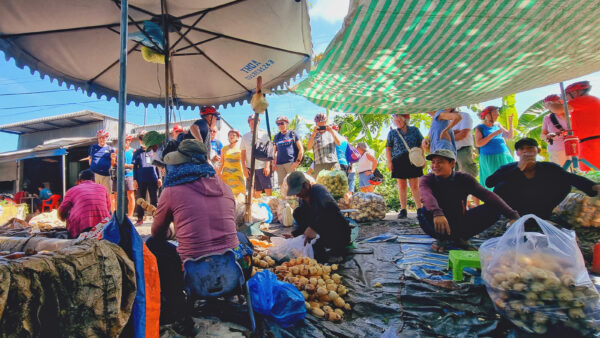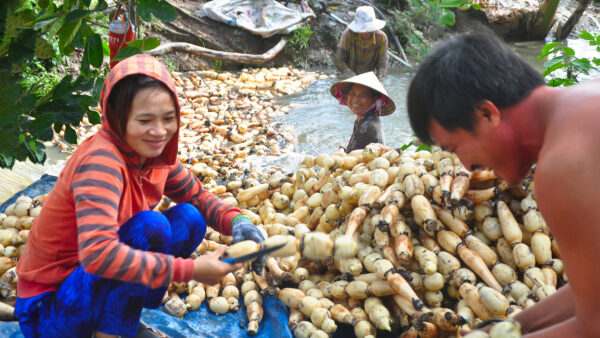Lotus roots in Chau Doc city are a symbol of purity and prosperity in Vietnamese culture, with a long tradition of cultivation and harvesting passed down through generations. This article explores the process of harvesting lotus roots in Chau Doc City, showcasing both traditional methods and modern techniques shaping the industry. From economic significance to health benefits and culinary delights, this guide offers insight into the enchanting world of lotus root harvesting in Chau Doc City along the Mekong Delta.

Introduction to Lotus Roots
Lotus roots are the tuberous rhizomes of the lotus plant, known for their distinctive appearance with holes running through the length of the root. These roots are crisp, slightly sweet, and often used in Asian cuisine for their unique texture and flavor.

Historical Significance of Lotus Roots in Chau Doc City
Lotus roots in Chau Doc city have deep cultural and historical significance. They have been a staple food and important ingredient in local dishes for generations, symbolizing purity and prosperity in Vietnamese culture.
Cultivation and Growth of Lotus Roots in Chau Doc City
Environmental Requirements for Growing Lotus Roots
Lotus roots thrive in wet, marshy environments with plenty of sunlight. The fertile soil of Chau Doc City provides the perfect conditions for growing these aquatic plants, allowing them to develop their roots underground while their leaves float on the water’s surface.
Seasonal Cycle of Lotus Root Growth
Lotus roots in Chau Doc city are typically planted in the spring and harvested in the fall. During the growing season, lotus plants require constant care and monitoring to ensure proper growth of the roots. The cycle from planting to harvest is a labor-intensive process that requires patience and skill.

Traditional Harvesting Methods of Lotus Roots
Hand Harvesting Techniques
Traditional lotus roots in Chau Doc City often involves skilled workers wading through the muddy waters, carefully digging up the roots by hand. This method requires precision to avoid damaging the delicate roots and has been passed down through generations.

Tools Used in Traditional Lotus Root Harvesting
Traditional lotus root harvesters often use simple tools such as wooden poles with hooks to gently lift the roots from the water and mud. These tools allow for a gentle approach to harvesting, ensuring that the roots remain intact and undamaged.
Modern Techniques for Harvesting Lotus Roots
Mechanized Harvesting Processes
Modern agriculture in Chau Doc City has seen the introduction of mechanized harvesting techniques for lotus roots. Machinery such as underwater harvesters and conveyor belts have streamlined the harvesting process, increasing efficiency and reducing labor costs.
Efficiency and Benefits of Modern Harvesting Methods
Mechanized harvesting methods not only speed up the process of gathering lotus roots but also ensure a higher yield and quality of the produce. These modern techniques have revolutionized the industry in Chau Doc City, making lotus root cultivation more sustainable and profitable for farmers.5. Economic Significance of Lotus Root Harvesting in Chau Doc City

Role of Lotus Roots in the Local Economy
Lotus root harvesting plays a vital role in the economy of Chau Doc City, providing income for local farmers and businesses. The cultivation and sale of lotus roots contribute significantly to the livelihoods of many families in the region, supporting sustainable agriculture and rural development.
Market Trends and Export Opportunities
In recent years, the demand for lotus roots has been on the rise, both domestically and internationally. Chau Doc City has seen a growing interest in lotus root products, leading to new market opportunities and potential for export expansion. With their unique flavor and texture, lotus roots have the potential to attract a wider consumer base beyond traditional markets.
Culinary Uses and Health Benefits of Lotus Roots
Popular Dishes Featuring Lotus Roots
Lotus roots are a versatile ingredient in Vietnamese cuisine, commonly used in dishes such as lotus root salad, stir-fries, and soups. Their crunchy texture and mild, slightly sweet flavor make them a popular choice for both home cooks and professional chefs looking to add a unique touch to their recipes.

Nutritional Value and Health Benefits of Lotus Roots
Aside from their culinary appeal, lotus roots are also packed with health benefits. They are low in calories and high in fiber, vitamins, and minerals, making them a nutritious addition to any diet. Lotus roots are known for their anti-inflammatory properties and potential benefits for digestion and overall well-being.
Challenges and Future Outlook for Lotus Root Harvesting Industry in Chau Doc City
Sustainability Issues in Lotus Root Harvesting
As the demand for them continues to grow, there are concerns about the sustainability of their cultivation. Practices such as overharvesting and environmental degradation could pose challenges to the long-term viability of lotus root harvesting in Chau Doc City. Implementing sustainable farming techniques and conservation efforts will be crucial for preserving this important industry.

Technological Innovations and Future Developments
The lotus root harvesting industry in Chau Doc City faces challenges that can be addressed through technological innovations and advanced cultivation practices. Implementing modern farming techniques like precision agriculture and eco-friendly methods can enhance efficiency, reduce environmental impact, and ensure long-term success for lotus production. Embracing innovation is crucial for the industry’s positive future. This harmonious blend of tradition and innovation showcases the rich cultural heritage and economic potential of lotus root harvesting in the city. By appreciating the culinary and health benefits of lotus roots, recognizing farmers’ dedication, and promoting sustainable cultivation practices, the industry in Chau Doc City stands as a testament to the enduring beauty and bounty of nature’s gifts.




